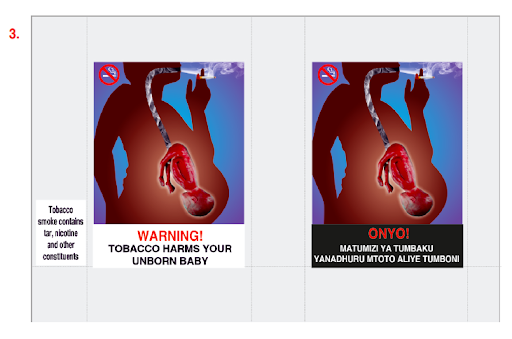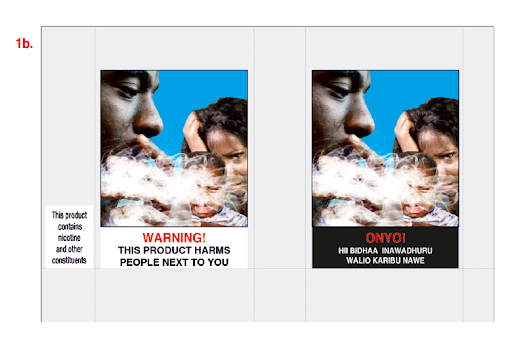Health advocates have urged that vivid, unsettling pictorial warnings cover 80 per cent of packets of cigarettes and other nicotine products.
The Ministry of Health last week published 13 proposed large graphic warnings on cigarette packs and pouches.
Currently, the law says a combined picture and text health warning must occupy at least 30 per cent of the front and 50 per cent of the back of smoked tobacco products.
Joel Gitali, head of the Kenya Tobacco Control Alliance, said civil society has already proposed amendments to the 2014 Tobacco Control Regulations to allow more impactful graphic warnings.
“We want enlarged warnings to cover 80 per cent of all sides of packaging of any nicotine and tobacco-related products,” he told the Star.
“And if the Tobacco Control Act itself is amended, then we have proposed the Act should mandate warnings to cover 90 per cent of the packets.”
Kenya had approximately three million tobacco users at the end of 2022, representing about 5.7 per cent of the population, according to the Ministry of Health.
Most anti-tobacco experts say raising prices and taxes are the single most effective way, coupled with other measures to reduce tobacco use. Tobacco control means health and wealth.
They say education doesn’t work with young people whose brains are not fully developed, can’t see 30 years into the future and want to look cool.
But the proposed regulations say nothing about increasing taxes and prices to discourage use.
Tobacco causes many ailments to the heart, lungs and other organs and kills 9,000 Kenyans every year – more than deaths from road crashes and murders combined.
If the changes are approved, graphic warning depicting impotence, cancerous growths and sick foetuses will be printed on new tobacco and nicotine products sold in Kenya.
Until now, only cigarette packets have such warnings.
“These warnings are very important because they speak even to those who can’t read and they attract attention. They also scare people and pass information more clearly and immediately compared to text,” Gitali said.
This is the first time Kenya is changing the warnings since they were introduced in 2016.



The Ministry of Health last week published a notice asking Kenyans to give views of the 13 images before they are gazetted.
“The Tobacco Control Act, 2007 controls the production, manufacture, sale, labelling, advertising, promotion and sponsorship of tobacco products in Kenya. Section 21 of the Act provides that tobacco products manufactured, imported, distributed and sold in Kenya should contain both text and graphic health warnings,” Health CS Susan Nakhumicha said in the notice.
The ministry called public participation sessions to discuss the graphics between May 2 and May 8 countrywide.
Some of the images show that using tobacco causes cancer and death. There is also a warning indicating nicotine pouches are not a safe alternative.
“The objectives of the graphic health warnings are to increase knowledge about risks associated with tobacco use, deter initiation to tobacco, reduce tobacco consumption and persuade tobacco users to quit. They also break the challenges of languages and the inability to read text-only messages,” Nakhumicha said.
The Consumer Information Network, a watchdog based in Nairobi, praised the ministry.
CIN chief executive officer Samuel Ochieng called on Kenyans to turn up during public participation and approve the new images.
“Tobacco is one of the leading risk factors for non-communicable diseases and graphic health warnings go a long way to inform the public of the health effects of tobacco. Let's make Kenya a tobacco-free nation.
“It will help save our people especially children, youth and women who are the major target and bear the greatest burden of tobacco effects,” he said.
Ochieng also supported plans to include the images on nicotine pouches, which are known to increase the risk of abortion and affect the brain of adolescent users.
“I'm further impressed that this time nicotine pouches and other nicotine and tobacco delivery systems such as e-cigarettes will be included,” he said.
The 2014 regulations to the Tobacco Control Act require that manufacturers of tobacco products rotate the picture and text warnings in a 12-month period.
The law and regulations do not state how frequently the Minister of Health must update the warnings and messages. However, the best practice by World Health Organization is that the warnings need to be changed every 12 to 36 months.
There is evidence health warnings on tobacco packaging are among the most direct and cost-effective means of communicating the health risks of tobacco use to the public.
In Kenya, health warnings were introduced as part of the 2007 Tobacco Control Act, which came into force in July 2008 and included requirements for 13 rotating text-only health warnings in Kiswahili and English.
In 2014, the government introduced the Tobacco Control Regulations which included 15 new images of smoked and smokeless tobacco packages.
The regulations were to be implemented in June 2015 but were delayed due to a legal challenge by cigarette manufacturers, who lost the case at the Supreme Court. The images were still introduced beginning September 2016.
Research shows the graphic pack warnings substantially increased effectiveness compared to text-only warning labels.
One study, “Quasi-experimental evaluation of Kenya’s pictorial health warnings versus Zambia’s single text-only warning: findings from the International Tobacco Control Project,” found that 27.8 per cent of Kenyan smokers were more likely to forgo a cigarette due to the graphic pack warning labels compared to 18.5 per cent of smokers viewing the text-only warnings.
“Kenya’s example offers the latest evidence that graphic pack warning labels work. With a database of tried and tested images and research all countries should follow suit,” the study by researchers from Kenya Medical Research Institute, the University of Nairobi, and other institutions, showed.
It is published in Tobacco Control BMJ Journal.

